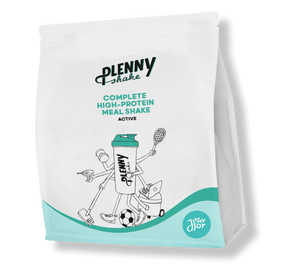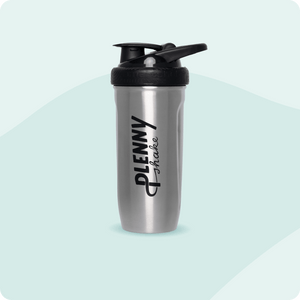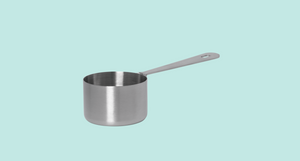
At Jimmy Joy, we love experimenting. We’ve been doing it since 2014, so we have quite some experience with it.
By experimenting and testing (and then experimenting and testing some more...), we make sure your meals are as healthy and tasty as scientifically possible.
And so for our latest experiment, we tested natural vs artificial flavouring. Our objective was simple: to find out which type of flavouring our community would like more.

Image: taste testers filling out a questionnaire
We performed a sensory testing with our panel group on our Plenny Shake v3.0 flavours without saying which was which. It was a blind taste testing!
And whaddaya know?
The test panel liked natural flavourings quite a lot more!
At Jimmy Joy we firmly believe in PtP: Pleasing the Palate! So we put our heads together and decided to move forwards with 100% natural flavouring for all our Plenny Shake v3.0 and Plenny Shake Active v3.1 flavours.

Image: The comparison of the Plenny Shake v3.0 Banana in the taste test.
Which flavours are already naturally flavoured?
- Banana (Plenny Shake & Plenny Shake Active)
- Strawberry (Plenny Shake & Plenny Shake Active)
- Chocolate (Plenny Shake & Plenny Shake Active)
- Passion Fruit (Plenny Shake)
- Coconut (Plenny Shake)
- Pistachio (Plenny Shake)
- Caramel Sea Salt (Plenny Shake)
- Coffee (Plenny Shake)
Which flavour is next?
- Vanilla (Plenny Shake & Plenny Shake Active)
We haven't found a natural vanilla flavour that we like yet. But we're trying out different ones to see if we can find a new favourite that's just as good as our current artificial one. We'll let you know what we find out!
If you’re a little confused about what natural or artificial flavourings exactly are and do, just keep reading!
What are flavourings anyway?
Flavourings are ingredients that are added to foods in very small amounts to give them a specific flavour or odour, or to enhance a flavour or odour. They have no nutritional purposes [1].
There are two types of flavourings:
- Natural flavourings
- Artificial flavourings
The U.S. Food & Drug Administration (FDA) describes natural flavouring as:
“[...] the essential oil, oleoresin, essence or extractive, protein hydrolysate, distillate, or any product of roasting, heating or enzymolysis, which contains the flavoring constituents derived from a spice, fruit or fruit juice, vegetable or vegetable juice, edible yeast, herb, bark, bud, root, leaf or similar plant material, meat, seafood, poultry, eggs, dairy products, or fermentation products thereof, whose significant function in food is flavoring rather than nutritional.” [2]
Wait, whaaat...?
In normal-people-language this means natural flavourings come from natural sources like spices, fruits, vegetables, herbs, roots, or other plant materials. But they can also come from meat, seafood, poultry, eggs, and dairy products.
So what is artificial flavouring?
Again, the FDA is at your service!
“any substance, the function of which is to impart flavor, which is not derived from a spice, fruit or fruit juice, vegetable or vegetable juice, edible yeast, herb, bark, bud, root, leaf or similar plant material, meat, fish, poultry, eggs, dairy products, or fermentation products thereof.” [2]
Soooo…?
So, simply put, this means artificial flavourings are flavourings that are not derived from, natural sources.

Which is better: natural or artificial flavouring?
One isn’t necessarily better than the other: chemically speaking, natural flavourings are no different than artificial flavourings, nor are natural flavourings any safer than artificial flavourings [3]
So when it comes to which one is “better”, at Jimmy Joy we just like to follow our taste buds.
Why do we use flavourings?
There’s an increasing demand for instant healthy meals that also taste great. But most of the awesome flavour in food comes from fat, salt, and sugar - which are not the healthiest of ingredients. They’re fine in moderation, but an excessive intake, over time, can have some seriously negative effects on your overall health.

And that’s where flavourings come in: they can significantly enhance the taste without changing much of the nutritional value of a product.
Flavourings also contribute to our sustainability mission: natural resources are becoming more and more scarce, but flavourings that are resource-efficiently produced can make sure you can continue to enjoy your favourite flavours.
Sources
[1] Food Standards Agency. (2020). Flavourings authorisation guidance. [online] Available at: https://www.food.gov.uk/business-guidance/regulated-products/flavourings-guidance [Accessed 22 Oct. 2021].
[2] Fda.gov. (2020). CFR - Code of Federal Regulations Title 21. [online] Available at: https://www.accessdata.fda.gov/scripts/cdrh/cfdocs/cfcfr/cfrsearch.cfm?fr=101.22 [Accessed 22 Oct. 2021].
[3] NPR.org. (2017). Is “Natural Flavor” Healthier Than “Artificial Flavor”? [online] Available at: https://www.npr.org/sections/thesalt/2017/11/03/560048780/is-natural-flavor-healthier-than-artificial-flavor [Accessed 22 Oct. 2021].
[4] Science in the News. (2015). The Flavor Rundown: Natural vs. Artificial Flavors - Science in the News. [online] Available at: https://sitn.hms.harvard.edu/flash/2015/the-flavor-rundown-natural-vs-artificial-flavors/ [Accessed 22 Oct. 2021].

 Everything You Need In One Meal
Everything You Need In One Meal
 Stay Full For 3-5 Hours
Stay Full For 3-5 Hours




















 Product added to cart
Product added to cart





















